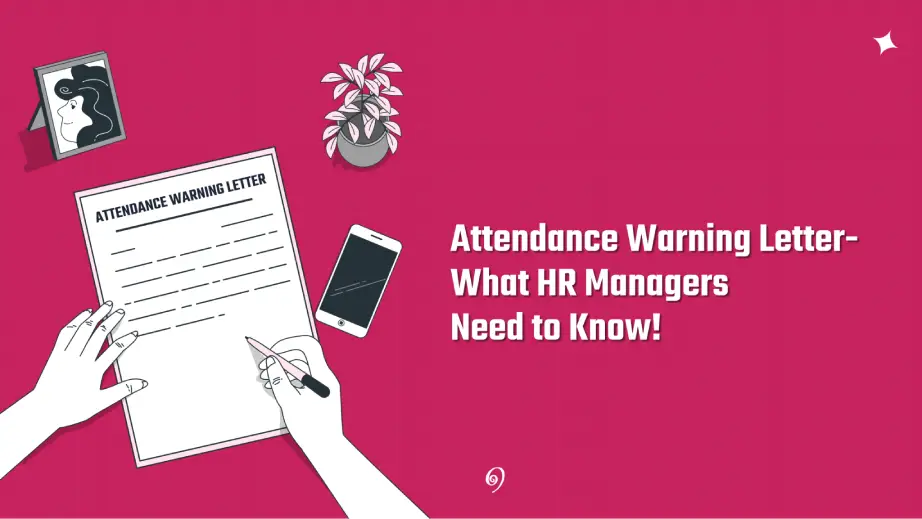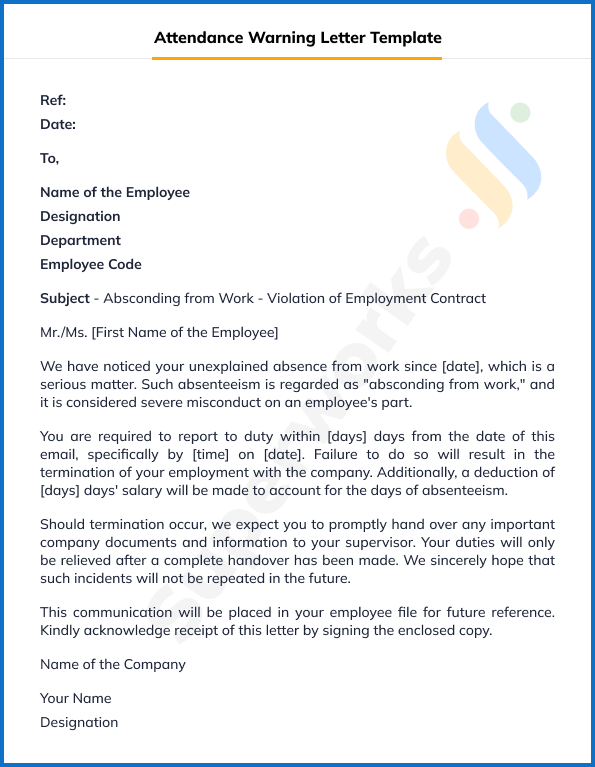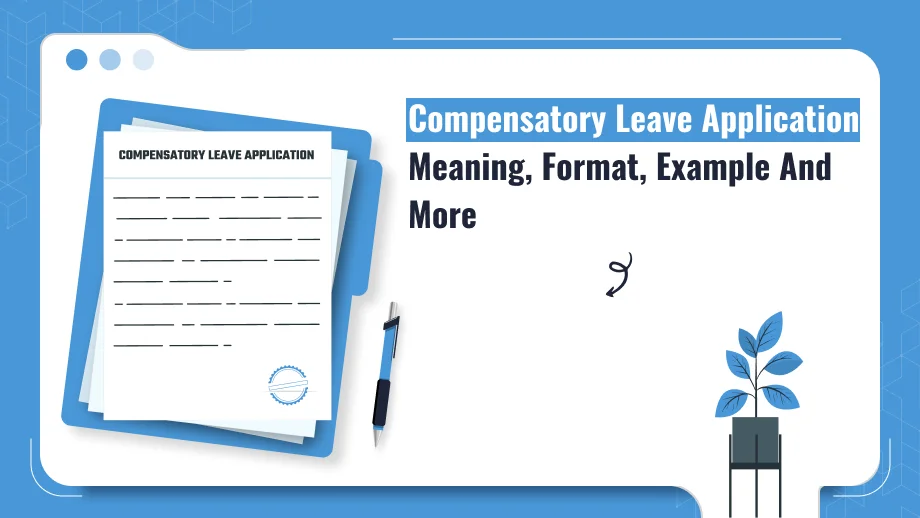Grab a chance to avail 6 Months of Performance Module for FREE
Book a free demo session & learn more about it!
-
Will customized solution for your needs
-
Empowering users with user-friendly features
-
Driving success across diverse industries, everywhere.
Grab a chance to avail 6 Months of Performance Module for FREE
Book a free demo session & learn more about it!
Superworks
Modern HR Workplace
Your Partner in the entire Employee Life Cycle
From recruitment to retirement manage every stage of employee lifecycle with ease.


Seamless onboarding & offboarding
Automated compliance & payroll
Track performance & engagement
Attendance Warning Letter: What HR Managers Need to Know!
- warning letter for irregular attendance
- 12 min read
- August 1, 2023

Have you ever faced the challenge of dealing with employee attendance issues within your organization? Attendance problems can disrupt workflow, affect team dynamics, and hamper overall productivity.
As an HR manager, it falls upon you to address these issues professionally and constructively. One powerful tool at your disposal is the Attendance Warning Letter – a key instrument for encouraging accountability and fostering a positive work culture till the onboarding of an employee.
In this blog, we will explore the ins and outs of crafting effective warning letters, understanding the importance of attendance management, and navigating the delicate balance between support and discipline. Get ready to unlock the secrets of successful attendance management and get a free attendance warning letter template.
Understanding Attendance Warning Letters!
First things first, let’s learn the basics of an employee attendance letter format or attendance warning letter format:
– Definition of an Attendance Warning Letter
It is a formal written communication issued by employers, educational institutions, or authorities to address concerns regarding an individual’s attendance record. It serves as a notification that the recipient’s attendance performance has been deemed unsatisfactory or below the expected standards.
Note: You can download directly from here and edit as per your need.
The letter outlines the specific attendance issues, such as excessive absences, tardiness, or unapproved leave, and highlights the importance of rectifying the situation promptly. It may also include the consequences of continued non-compliance with attendance policies.
A warning letter for irregular attendance aims to alert the recipient about the seriousness of the matter and encourages them to take corrective actions to improve their attendance and overall commitment.
If you want a sample warning letter to employee for attendance or other warning letter templates, download Superworks HR toolkit.
– Situations or Reasons to Issue an Attendance Warning Letter
Issuing an attendance warning letter for employee is warranted in various situations where an individual’s attendance falls below acceptable levels. Some common reasons to issue such a letter include:
1. Excessive Absences: When an employee or student accumulates a significant number of unexcused absences within a defined period, a warning letter for absence is often issued.
2. Chronic Tardiness: Persistent late arrivals to work or classes can disrupt operations and affect productivity, making it necessary to address the issue formally.
3. Unapproved Leave: Taking time off without proper authorization or not following the prescribed medical leave application format request process may lead to the issuance of a warning letter to an employee for absence.
4. Frequent Sick Leaves: While genuine illnesses are unavoidable, a pattern of excessive sick leaves can trigger concerns and warrant a warning letter.
5. Violation of Attendance Policies: Non-compliance with established attendance rules, such as not providing timely notifications for absences, may lead to a late coming warning letter.
6. Impact on Team or Class: When an individual’s attendance negatively affects the overall team dynamics or classroom environment, intervention becomes essential.
7. Legal or Contractual Obligations: In some industries or educational settings, there might be legal or contractual requirements for maintaining specific attendance standards.
8. Performance & Productivity Issues: Poor attendance can often correlate with decreased performance and productivity, necessitating intervention through a warning letter for poor performance and attendance.
9. Habitual Disregard for Attendance Guidelines: If an individual continuously disregards attendance policies despite prior informal warnings, a formal and final warning letter for poor attendance becomes necessary.
10. Workplace or School Culture: Addressing attendance issues helps promote a positive and responsible culture within the organization or educational institution.
An attendance warning letter to employee aims to communicate these concerns clearly, urging the recipient to take corrective actions and improve their attendance to ensure a conducive and productive environment.
– The Significance of Addressing Attendance Issues Promptly
Addressing attendance issues promptly is of paramount importance in both educational and professional settings. Let’s dig deeper and learn some key reasons why it holds such importance:
1. Maintain Productivity: Regular attendance ensures that all team members or students contribute to their fullest potential, optimizing productivity and achieving organizational or educational goals, particularly through effective project purpose management.
2. Uphold Team Morale: In a team-based environment, absent or tardy individuals can disrupt team dynamics, affecting morale and cohesiveness. Addressing attendance issues and written or verbal warnings for attendance helps maintain a positive atmosphere.
3. Timely Project Completion: In workplaces, meeting project deadlines is crucial. Promptly addressing attendance issues ensures projects progress smoothly without unnecessary delays.
4. Identifying Underlying Problems: Addressing attendance issues early allows for timely intervention to identify and support individuals facing personal or professional challenges.
5. Mitigating Disciplinary Actions: Taking prompt action can prevent further escalation of attendance problems, avoiding more severe disciplinary measures.
6. Positive Organizational Image: For businesses or educational institutions, proactive handling of attendance policy and issues contributes to a positive public image and can attract and retain stakeholders.
In conclusion, addressing attendance issues in a timely manner is crucial for maintaining a productive, cohesive, and positive environment, benefiting individuals and the organization or institution as a whole.
Components of an Employee Attendance Warning Letter
Now that you understood the basics of an attendance warning letter, let’s dig deeper and learn the right techniques to draft the perfect letter format:
– Must Have Elements in an Employee Attendance Letter Format
The elements to include in an attendance warning letter vary from company to company but here are some must-have details:
1. Recipient’s Information:
This section should clearly identify the recipient of the letter, whether it’s an employee, student, or any other relevant individual. Including the recipient’s full name, job title, or grade/class ensures the letter is directed to the right person and avoids any confusion about the intended recipient.
2. Attendance Issues:
Provide specific and detailed information about the attendance problems the recipient is facing. Mention the dates and instances of absences, tardiness, or unapproved leave to show that the concerns are well-documented and not generalized.
3. Impact Statement:
Describe how the attendance issues have affected the team, department, or class. Emphasize the importance of regular attendance in maintaining productivity, teamwork, and overall success within the organization or educational setting.
4. Expectations:
Clearly state the organization’s or institution’s expectations regarding attendance. This may include the number of allowable absences, punctuality requirements, and procedures for requesting leave.
5. Improvement Plan & Consequences:
Offer guidance and support for improvement, such as suggestions for addressing attendance issues or accessing available resources. Additionally, clearly communicate the potential consequences if the attendance problems persist, which may involve further disciplinary actions or repercussions in accordance with the attendance policy. This provides a clear incentive for the recipient to take the matter seriously and work towards improving their attendance.
Also, remember to keep the letter concise and professional while addressing the concerns effectively.
Read More – 5 Myths of Warning Letter Format

Want to save 80% time on letter drafting? Get 300+ FREE templates!
Try our HR toolkit which is designed for professionals like you who wish to save time for other crucial business tasks. With our HR toolkit, letter writing becomes easier, faster, and smarter.
So, do not think twice and try Superwork’s comprehensive HR toolkit at the earliest.
– What Tone & Language to Use?
In an attendance warning letter, it is crucial to maintain a professional, respectful, and clear tone and language. Adopt a formal approach, avoid colloquial language, and express the concerns objectively without making accusatory remarks.
Treat the recipient with politeness and respect, focusing on the facts regarding the attendance issues. Be concise and articulate in communicating the message to ensure clarity. Use encouraging language to motivate the recipient to improve their attendance, offering support and resources to aid them in meeting expectations.
Refrain from using emotional or threatening language, and instead, refer to relevant company or school policies as the basis for the concerns raised. A professional and supportive tone will enhance the letter’s effectiveness in addressing attendance problems.
Tips for Composing a Well-Structured Attendance Warning Letter
Here are five very useful tips for composing a well-structured Attendance Warning Letter:
1. Clear & Direct Communication:
Clear and direct communication is essential when composing an Attendance Warning Letter. Start the letter by explicitly stating its purpose – addressing attendance concerns. Avoid ambiguity and provide specific details about the attendance issues, including dates and instances of absences or tardiness.
Use straightforward language to ensure the recipient comprehends the seriousness of the matter without confusion. Being explicit about the reason for the letter establishes transparency and sets the tone for a focused discussion on attendance improvement. By conveying the message clearly and directly, the recipient understands the purpose of the letter from the beginning, making it more likely for them to take the necessary corrective actions.
2. Professional & Respectful Tone:
Address the recipient with courtesy and dignity, even when discussing sensitive attendance issues. Avoid using harsh language, accusations, or any form of disrespect.
By adopting a respectful tone, the letter shows that the organization or institution values the recipient and their contributions. This approach encourages a more receptive attitude from the recipient, fostering constructive dialogue. Emphasize the mutual commitment to address attendance concerns collaboratively, assuring the recipient that the intention is to support their growth and success within the organization or educational setting.
3. Highlight Impact & Consequences:
Describe how the recipient’s attendance problems affect the team’s dynamics, productivity, or learning environment in an educational setting. By illustrating the repercussions of poor attendance, the recipient gains a deeper understanding of the significance of addressing the concerns promptly.
Emphasize that adherence to attendance policies is crucial for maintaining a positive and cohesive work or learning atmosphere. Clearly stating the potential consequences, such as further disciplinary actions, underscores the seriousness of the matter and encourages the recipient to take corrective actions seriously.
4. Offer Support & Guidance:
Show a willingness to help and provide practical suggestions for addressing attendance issues. Offer resources such as counseling, flexible work arrangements, or academic assistance to aid them in overcoming any challenges they may be facing.
Demonstrating a supportive approach conveys that the organization or institution is invested in the recipient’s success and well-being. By offering constructive assistance, the recipient is more likely to feel encouraged and motivated to take steps towards improving their attendance and meeting the organization or institution’s expectations.
5. Encourage Positive Action:
End the letter on an optimistic note, motivating the recipient to take immediate and positive steps towards improving their attendance. Express confidence in their ability to rectify the attendance issues and emphasize that improvement is within their reach.
Reinforce the value they bring to the organization or educational institution and the potential for personal and professional growth through better attendance. By fostering a positive mindset, the recipient is more likely to respond proactively, taking ownership of their real-time attendance and committing to positive changes for a successful future.
By incorporating these tips, your Attendance Warning Letter will effectively convey the concerns, encourage improvement, and maintain a positive approach to addressing attendance issues.
Read More – 5 Common Mistakes to Avoid When Drafting a Relieving Letter – Get Free Template!
How to Draft an Attendance Warning Letter?
You can write an warning letter for irregular attendance in just four easy steps:
– Collect Information
Before you start drafting the attendance warning letter, gather all the relevant information related to the employee’s attendance record. Review attendance logs, timesheet, and any previous warnings issued, if applicable. Ensure accuracy in the data you’re presenting to the employee. Having a clear understanding of the attendance pattern will help you create a factual and objective letter.
Example: “After a thorough examination of your attendance records over the last six months, we have observed a notable accumulation of unexcused absences and instances of tardiness.”
– Mention About Any Measures Taken in the Past
If the employee has received prior warnings or if there have been any corrective actions in the past, acknowledge them in the letter. It’s essential to let the employee know that attendance has been a concern previously and that appropriate steps have already been taken to address the issue.
Example: “It is important to note that this is not the initial occurrence of attendance-related issues. We have previously discussed this matter in our informal meetings on [date], and you were issued a verbal warning on [date].”
– Explain the Effects
Clearly explain to the employee the impact of their attendance issues on the organization, their team, and their individual performance. Emphasize how consistent attendance is crucial for meeting deadlines, maintaining team cohesion, and achieving overall company goals.
Example: “Your frequent absences have resulted in missed project deadlines, increased workload on your colleagues, and hindered team collaboration. Moreover, it has adversely affected your performance evaluation, hindering your career growth prospects within the company.”
– Clearly State Next Steps
Outline the specific steps the employee must take to improve their attendance and the consequences if no improvement is observed. Be specific about the timeframe for improvement and any support or resources that will be provided to help them succeed.
Example: “We expect that you will do the needful improvement in your attendance in the coming days. You are required to maintain punctuality and ensure regular attendance for the next three months. Non-compliance may lead to additional disciplinary measures, potentially culminating in termination of employment.”
Now, get an attendance warning letter sample in the next section!
A Smart Attendance Warning Letter Template For You
Parting Thoughts
In conclusion, by ensuring clear and direct language, a professional tone, and highlighting both the impact and potential consequences, HR managers, with the support of our HR toolkit, can effectively address attendance issues.
Armed with this knowledge, you can wield the attendance warning letter as a catalyst for positive change, promoting a culture of responsibility and accountability within the organization, and ultimately fostering greater success for both employees and the company as a whole.








